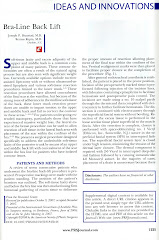A frequent concern of patients considering a tummy tuck is the final scars. Rightfully so, all cosmetic procedures involving removing large amounts of skin and soft-tissue will need to have some type of scar. The two-part question that prospective tummy tuck patients should consider is:
How will the final scar look and feel when I am nude? And, will it the scar be visible when a I am wearing a two piece bikin, low rider jeans, underwear, etc?
Since we can all agree that a scar will be present after a tummy tuck the the answer to the above questions should help to alleviate most concerns about scars.
How will my Tummy Tuck Scars look and feel when I am nude?
It is my experience and that of my colleagues that tummy tuck scars uniformly heal thin, without keloid or hypertrophic qualities. A keloid scar is one that becomes so thick that the borders of the scar are beyond the area of the initial incision. A hypertrophic scar is a scar that heals with above normal amount of thickness but remains overlying the area of the incision. Hypertrophic scars are bad, keloid scars are really bad. Quite frankly I have never seen keloid scars resulting from a tummy tuck procedure either from my own patients or from patients who have had their surgery elsewhere. Hypertrophic scars usually occur from one of several factors including: beyond the limit excessive tension on the closure, inadequate suturing, infection, or otherwise poor healing resulting from medical issues or insufficient blood supply. With current knowledge, skills, and technology, hypertrophic scars from the tummy tuck procedure should be a very rare event. Correcting a hypertrophic scar starts with identifying the cause and revising the scar. It is usually a very straight forward procedure that frequently can be performed under local anesthesia with or without sedation. In most cases a drain is not needed and in a good number of cases an abdominal binder is not needed as well.
Other types of non-ideal tummy tuck scars include very thin and wide scars, asymmetric scars, and discolored scars. Very thin and wide scars usually indicate that the stronger connective tissue underlying the skin did aid the skin in healing properly. This can be he result of poor tissue quality or improper repair of this stronger, deeper tissue. Revision of these scar usually involves removal of the thin scar and proper repair of the thicker deeper underlying tissue. Asymmetric tummy tuck scars are usually the result of the tummy tuck design although if one side of the abdomen has previous scars then asymmertic healing can also occur. Tummy tuck scars that are either too light or too dark can be corrected through revision or through non-surgical means. Dark scars can be lightened with certain creams, light scars can be corrected with something called medical trepenation. Some of my research during my training focused on the treatment of low pigment scars and this process seemed promising.
How will my tummy tuck scars look when I am wearing certain types of clothes including a bikini, low-rider jeans, and mid-drift bearing shirts?
This is a particular passion for me in terms of the tummy tuck procedure. What is the point of getting a tummy tuck if you cannot show your tummy afterwards without people noting you have had surgery. In order to accomplish this the final incision lines of a tummy tuck must be hidden. The lower incision of the tummy tuck must be kept very low in the panty line (except for reverse tummy tuck where it should be hidden in the breast fold) and the belly button incision must be hidden within the belly button.
To accomplish this it is very important to design the tummy tuck procedure properly. The location of these incisions in the end is almost solely dependent on the design and execution of the tummy tuck procedure by the plastic surgeon. Correction of high or visible tummy tuck scars often requires more than just a tummy tuck scar revision. It frequently involves a complete tummy tuck repair sometimes also known as a complete tummy tuck re-do. This is essentially the full tummy tuck redone from beginning to end. For more information on this, please see my previous post on tummy tuck repair.
In terms of tummy tuck scar care, scar care creams such as Miderma or Scarguard can help but only if everything discussed above has been properly addressed.
In summary, anyone that is a good candidate for a tummy tuck must decide if it is worth it to them to trade a better looking tummy for a scar. This should be easily answered "Yes" if there is confidence about the appearance and location of the final scars as discussed above.
All the best,







